NDVI stands for "Normalized Difference Vegetation Index". NRG stands for "Near-infrared / Red / Green". NDVI and NRG are both ways to visualize the amounts of infrared and other wavelengths of light reflected from vegetation. Because both these methods compare ratios of blue and red light absorbed versus green and IR light reflected, they can be used to evaluate the health of vegetation. It's a snapshot of how much photosynthesis is happening. This is helpful in assessing vegetative health or stress. (Read more here: https://www.agronomy.org/publications/jeq/articles/36/3/832) ## Do-It-Yourself These techniques for vegetation analysis were developed for satellite imagery, but at Public Lab, we've been working a lot on capturing infrared imagery using our DIY [near-infrared camera](/wiki/near-infrared-camera) setup, and combining it with visible bands to produce NDVI images such as the one above. ## What these images mean What exactly are these images we're trying to make? What do they tell us about vegetation, and why? These diagrams should help to understand what it is we're doing and why these are good ways to analyze plant life. ## The NDVI equation [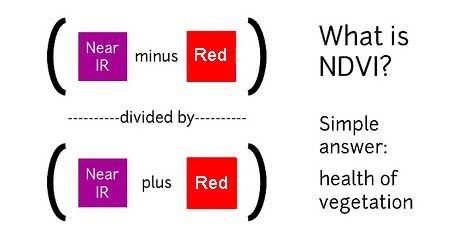](/i/44723) **NDVI = (Near Infrared - Red)/(Near Infrared + Red)** NDVI is a ratio which tries to emphasize photosynthesis while filtering out sun glare. The above equation is run for every pixel, using source data from an infrared photo and a visible light photo, like this pair: [](https://publiclab.org/system/images/photos/000/021/771/original/5390895115_c9d4d38fec_o.jpg) The result can be false-colored to make the high-photosynthesis areas more clear, and used to examine where plants are and how healthy they are. [](https://publiclab.org/system/images/photos/000/021/770/original/PetVISNDVIcomp.png) _Figure above: Normal color photo (right) and normalized difference vegetation index (NDVI) image (left). NDVI image was derived from two color channels in a single photo taken with a camera modified with a special infrared filter. Note that tree trunks, brown grass, and rocks have very low NDVI values because they are not photosynthetic. Healthy plants typically have NDVI values between 0.1 and 0.9. -- @cfastie_ ### Activities Here are a range of activities you can do to produce and interpret your own NDVI imagery, whether downloaded from a satellite imagery provider or [collected yourself using a DIY technique](/wiki/multispectral-imaging) [activities:ndvi] ****   Most DIY converted cameras today (those from Public Lab) use RGN instead of NRG, so the blue channel represents infrared instead of the red channel. That looks like this: [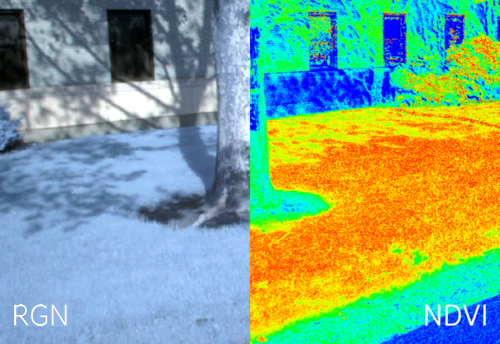](/i/45468?s=o) **** ## NRG imagery Some people are also interested in producing NRG imagery (like the below image), where `Near-Infrared, Red, and Green` are used to compose a picture instead of the usual `Red, Green, and Blue`. [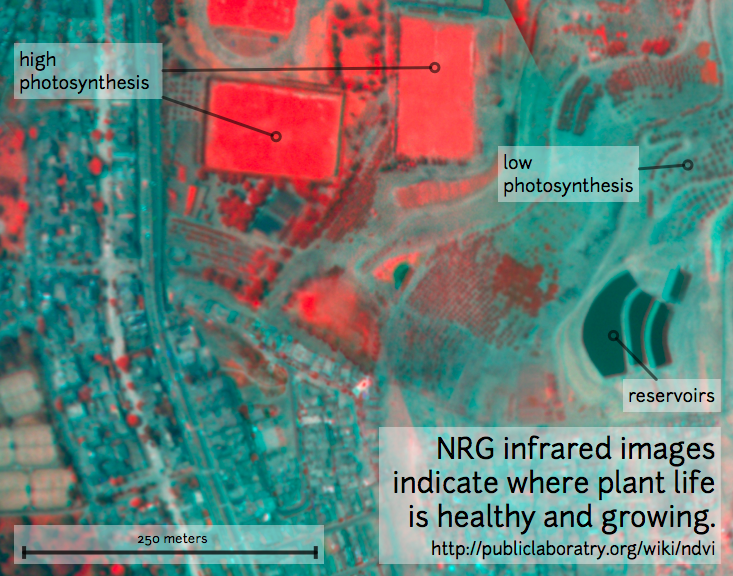](/i/25064) This diagram explains the swapping, which allows us to 'see' infrared as if it were a normal color: [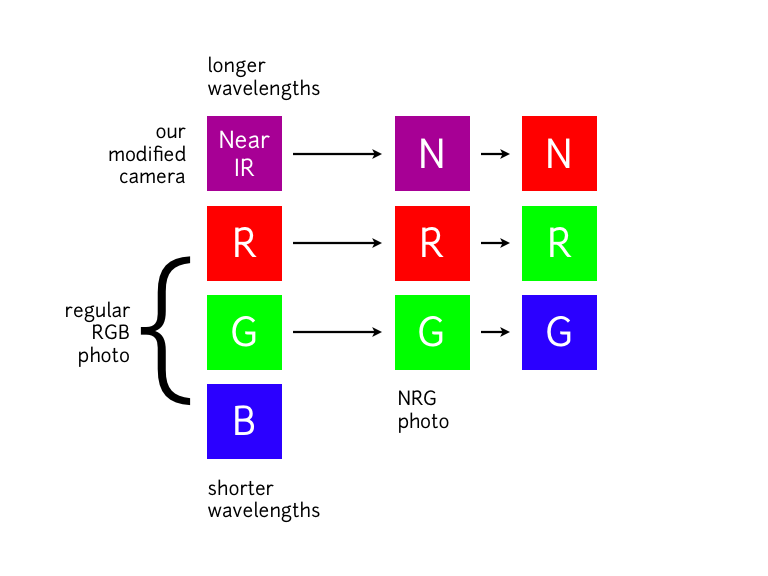](/i/25063) **In NRG images, the deeper and clearer the red color, the denser and healthier the vegetation (more or less).** ### Questions [questions:ndvi] ### Other examples of DIY NDVI imaging From around the internet: Begin watching at 2 minutes to see the resulting imagery: *This topic is part of the [Grassroots Mapping Curriculum](/wiki/mapping-curriculum) series.* **** [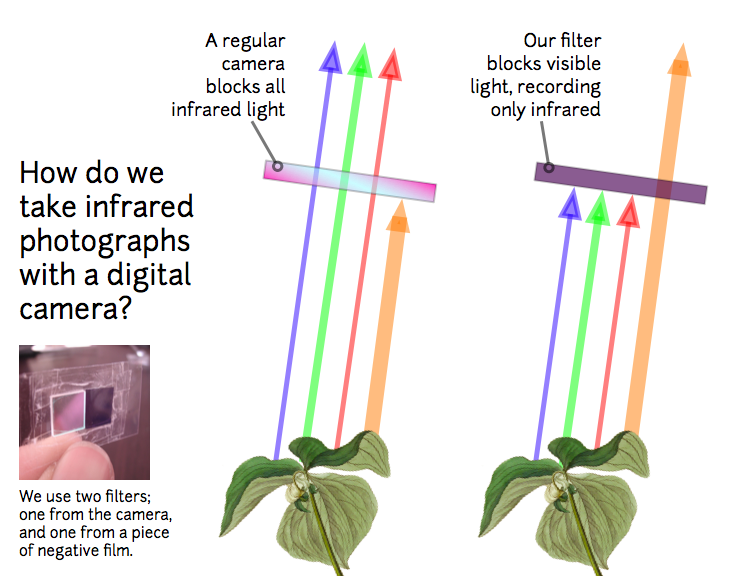](/i/25066) [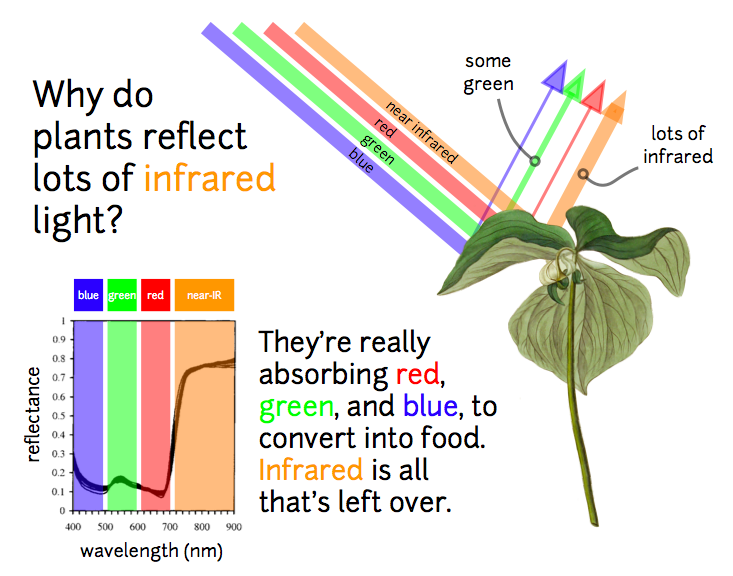](/i/25065) ...
| Author | Comment | Last activity | Moderation | ||
|---|---|---|---|---|---|
| warren | "Hi! It could be interesting to try measuring the berries themselves as well; check out the spectrometer work by this group for a reference! #webval..." | Read more » | about 4 years ago | |||
| cfastie | "If photos are taken of plants in two treatments (top and bottom) with the same camera settings (all manual control) under the exact same lighting c..." | Read more » | about 4 years ago | |||
| M0nk3y | "Hi there, i did'nt wanted to re-do a topic that would have been really similar as this one. I hope i will be enough precise to get an answer to my ..." | Read more » | about 4 years ago | |||
| warren | "Yes of course!!! " | Read more » | over 4 years ago | |||
| yaina | "This is this illuminating article for all of us. Extremely incredibly seriously incomprehensible content parts. We essentially gain searching state..." | Read more » | over 4 years ago | |||
| lev29 | "Thank you, Chris! You've given me much to read and think about, but please, don't misconstrue that as meaning you shouldn't add any additional pert..." | Read more » | over 4 years ago | |||
| cfastie | "Using green foliage (or chlorophyll) to set a custom white balance deserves more consideration than I gave it in my last comment. Foliage absorbs r..." | Read more » | over 4 years ago | |||
| cfastie | "The goal of the custom white balance hack is to fool the camera into wildly exaggerating the brightness of the blue channel (when using a red filte..." | Read more » | over 4 years ago | |||
| lev29 | "Thank you so much, Chris! With respect to what to use as a reference to calibrate the White Balance (WB), I have not yet "digested" whether your re..." | Read more » | over 4 years ago | |||
| cfastie | "If your K610 filter is a cutoff filter that passes wavelengths greater than 610nm and blocks shorter wavelengths, then it is similar to many filter..." | Read more » | over 4 years ago | |||
| lev29 | "Thank you, Chris, for helping to clarify my question. In fact, as you suspected, I was misusing the term "bandpass"! Those I signify with a "K" fol..." | Read more » | over 4 years ago | |||
| cfastie | "`>> for simple bandpass filters, I use the letter "K" followed by the approximate cutoff wavelength Are your filters bandpass filters or cut..." | Read more » | over 4 years ago | |||
| ThomasTaufan | "Chris, please look at my image taken from modified camera using red filter bought from Public Lab. Is this the correct results or should I do some ..." | Read more » | over 4 years ago | |||
| Bronwen | "I don't own a drone myself, but I do see lots of camera lenses marketed for different drone camera models (I've used some of these for our microsco..." | Read more » | over 4 years ago | |||
| Bronwen | "We do have some information already tagged with drone/ndvi " | Read more » | over 4 years ago | |||
| zomb23 | "Hi Chris, thank you for the quick and comprehensive response. That sounds really promising. I will look into chlorophyll fluorescence and if/how I ..." | Read more » | over 4 years ago | |||
| cfastie | "I think NDVI will provide some information about the photosynthetic rate of mosses. Moss leaves capable of rapid photosynthesis will probably be ab..." | Read more » | over 4 years ago | |||
| nstarli | "Where can I find the blue calibration card? I could not find it on the public lab store. " | Read more » | over 4 years ago | |||
| warren | "and! https://publiclab.org/infragram-pi " | Read more » | over 4 years ago | |||
| warren | "Just noting that our Infragram Pi Cam kits now ship with onboard software and WiFi: https://store.publiclab.org/collections/diy-infrared-photograp..." | Read more » | over 4 years ago | |||
| nickyshen0306 | "Thanks for giving me so many solutions!! I will try it. " | Read more » | over 4 years ago | |||
| lfent | "@cfastie I found that I needed the heavy cyan filtration (at the expense of all the exposure variables you mention) to achieve an image approximati..." | Read more » | over 4 years ago | |||
| cfastie | "@lfent, Is there any difference between using two filters and using one filter if both photos are exposed so the photos have the same general brigh..." | Read more » | over 4 years ago | |||
| lfent | "Yes, a cyan filter will block the red light from the red-NIR pixels, may I suggest the Rosco 4390 CalColor 90 Cyan gel filter. I found that I need ..." | Read more » | over 4 years ago |